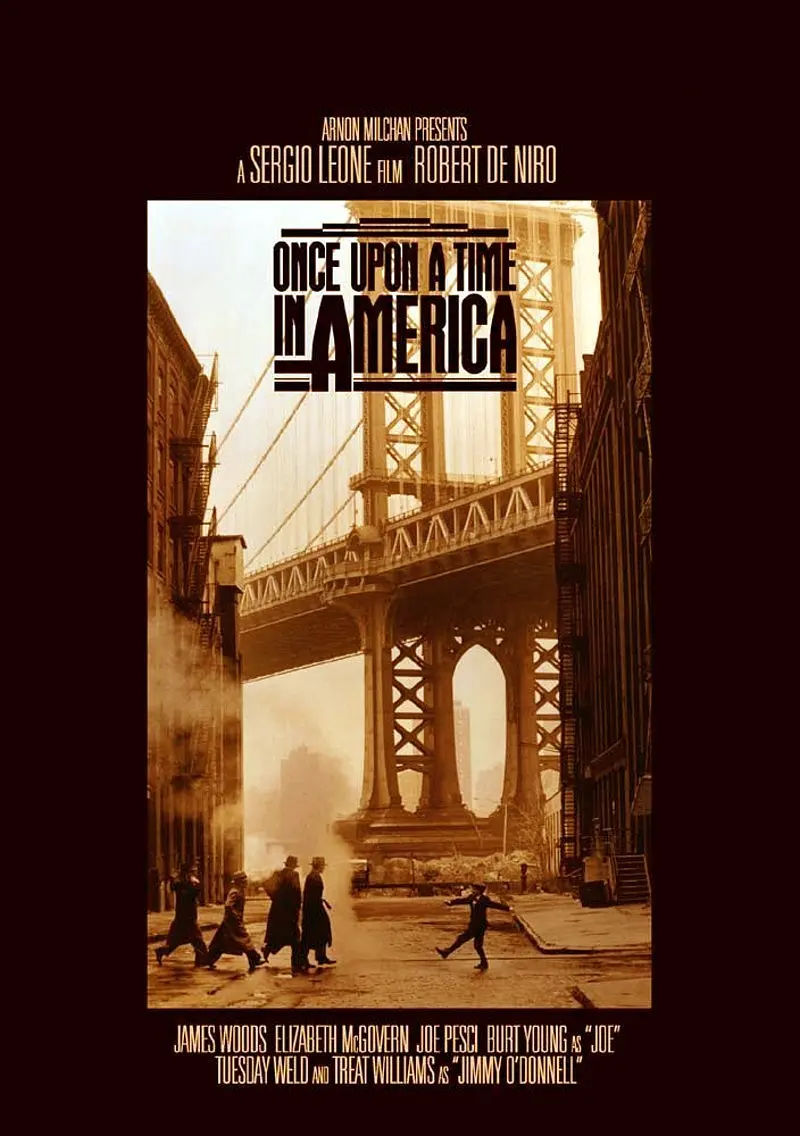Once Upon a Time in America: the movie you can’t afford not to see if you’re a manThe title above is a nasty way of putting it but close to the truth, and the title below is a trim way of putting it but close to pretending to be light.Once Upon a Time in America: A Life of MeaningIntroductionNothing is perfect, and neither are movies. If I were to choose only one movie that is close to perfection, I would choose “Once Upon a Time in America” for my humble viewing and taste. Although it did not harvest in the Oscars, the three major European film festivals to show off the award, imdb ranking is not conspicuous, the story and skills are not how to shock the world.
But “Once Upon a Time in America” is a different film, its mixed life, prose poem-like lyrical mood, as if a distant narrative perspective, meaningful character settings, so that it is still more than 20 years later, still exudes a long-lasting glow, that is a yellowish glow, soft and bright.
I. The mixed tastes of life
It has been said that “Once Upon a Time in America” has all of life in it, and this is the most concise and accurate movie review. The beauty of life does not lie in the beauty itself, but in the mixture of beauty and ugliness that people have experienced and experienced.
Evil is in everyone’s heart and surroundings. Noodles (Noodles) viciously raped Carol (Carol) during the diamond robbery, and could not find any excuse for him, and at that moment evil took over Noodles’ soul. Max’s insidious death of his own brother to keep his fortune is just a clear evidence of human filth.
So is goodness. When Dominic, who was in Noodle’s arms, died after saying “I slipped”, the young Noodle stabbed the murderer to death despite the arrival of the police, which was the guidance of brotherhood and the inevitability of his good nature. Carol is an uncompromising slut, but to Max gave the most love.
Complicated people originally have no good or bad nature, if forced to distinguish, can only be the unchangeable reality, or fate. Max’s final confession cannot erase his vicious life; Dominic lost his young life, but achieved the most glorious humanity in the film. At the end of the film, noodles who wanted to snitch to save his brother lay alone in the opium store and laugh, good and evil finally meet in the battle of life, evil always needs to be redeemed, and this redemption is good.
Second, prose poem-like lyrical mood
In my opinion, there is no director who dares to poetize the film so thoroughly as Sergio Leone, which transcends the director’s own “Bounty Trilogy” and other “macaroni”. It is also different from the golden formula of the gangster films represented by “The Godfather” and the films of Seacrest.
The beauty of the images also reflects the beauty of life. When Noodle sees Deborah dancing through the brick cracks in the wall, the film’s light and shadows are soft and glowing, and the awakening of a teenager’s soul is thus complete. And when the simple Patsy (Patsy) waiting for Peggy (Paggy) with a cream cake, in the budding sexuality and the temptation of food, we see the innocence of Patsy eating cake and our own childhood past.
Even the ugly is given a forgiving color by the director in the flow of camera and light and shadow. When Deborah rejects Noodle’s advances, the mute Noodle destroys the dream of his life in the most vulgar way. The rape in the back seat of the car with its cramped atmosphere is not so much a revenge on Deborah as it is Noodle’s self-abandonment.
Ennio Morricone, Leone’s royal soundtrack master, infuses the film with a whimsical and delicate score. The use of reed pipes, harmonica and trumpet is stunning, and with the soothing and simple melody, the viewer is enthralled in the nostalgic atmosphere of the streets of New York City in the early 1900s, 1930s and 1960s, with a calm and restrained approach to the rhythm of human nature and life’s ups and downs, and the lyrical meaning slowly flows.
The perspective of the narrative as if it were a lifetime ago
The excellence of “Once Upon a Time in America” is also shown in the dynamic way of narration, and the poetic use of interpolation is perfectly reflected in this film. In the growing up of Noodles and his brothers, the youthfulness, middle-agedness, and the woodenness of old age are overlapped together, and the dreams and mutations, losses and returns of life are shown to the viewer in this interlacing, allowing us to see ourselves in the time travel, as if we were in a different world.
Just like the pocket watch that made Noodles and Michaels meet and leave each other, lost and found, gained and lost, in the cycle of time – what time is it in 24 hours? — things are different. Another example is the opening minutes-long phone ringing, which also travels through time and space, connecting to the scene where the brothers were murdered, the smokehouse where Noodles was physically and mentally exhausted, the brothers’ mutual cherishing as a teenager, the desire to talk in old age, and finally, only to land on the phone where Noodles kindly betrayed the news to the police chief.
The change of camera is also an expression of meaning. When the young brothers sink the salt smuggling experiment successfully, the water surface is a plain with a hazy color, this skillful use of light and shadow hinted at the protagonists seemingly bright but actually dark future. And when Noodles religiously dating Deborah in the luxury hotel, Deborah selected a table outside the window is the cold tone of the sea, perhaps at that moment, waiting for Noodles is destined to be cold and helpless.
Four, the meaningful character setting
The story of brothers against each other is not new, the gangster theme is “The Godfather” before the pearl, but “Once Upon a Time in America” of the six brothers, noodles and Max’s hidden rivalry, Pai Xi and slant-eyed (Cockeye), and Fat Moe (Fat Moe) and Dominic’s simple and sincere, but still shows the extraordinary dramatic tension. Together with Deborah, Carol and Peggy, three women with different character traits, this movie about life and growth becomes complete and believable.
Robert De Niro’s performance in this film is the pinnacle of his career, not to deny his great performances in Taxi Driver, Raging Bull, Goodfellas, The Deer Hunter and Stolen Fire, but in 1983, De Niro’s form would have been the true peak of his career. In 1983, De Niro was at the true peak of his career.
De Niro turned 40 that year, which is a peak for an actor. He had the best experience, feeling and form, and a masterpiece like “Once Upon a Time in America” was a mutual blessing. He interprets Noodle’s middle-aged mumbo-jumbo and depravity, his elderly compassion and perseverance so convincingly that it’s hard to imagine that anyone else would have made us sigh with sadness for this total jerk.
Max’s murderous brother’s shady and inner torment all emerge on James Woods’ knife-like face. Similarly, Deborah’s vanity and vulnerability, Fatmore’s cowardice and loyalty, Carol’s debauchery and sincerity, all vividly and exceptionally under the soulful performance of the actors.
What cannot be forgotten, of course, is Dominic’s angelic face and unforgettable street bouncing, and little Patsy ate a bite of cream cake.
End
Just like we can’t see through the complexities of life, there are too many details and feelings in “Once Upon a Time in America”, and the more you say, the more you leave out. There have been too many reviews of this film – originally a story about a person’s life, who can say all the life – each one just expresses feelings and emotions mixed with personal experiences.
Instead of saying that the ultimate fate of noodles is the destruction of life’s dreams, it is better to say that he completed the redemption of self in the walk, which transcends the moral preaching of good and evil, towards the starting point of full of deep feelings, at that moment of destruction is rebirth, silence is the best cry.

